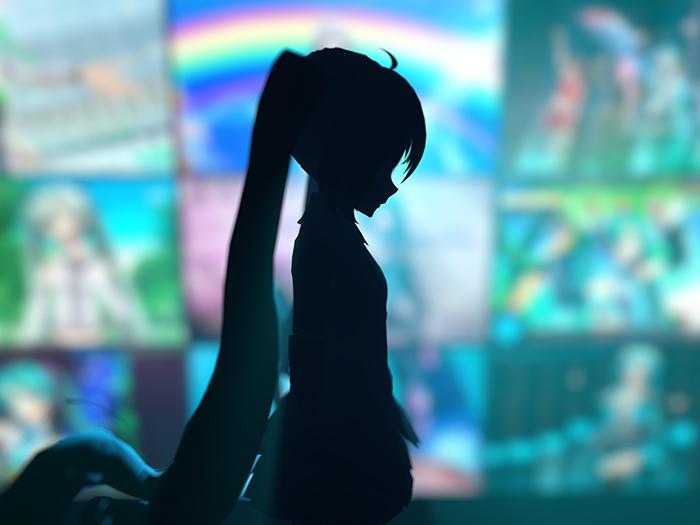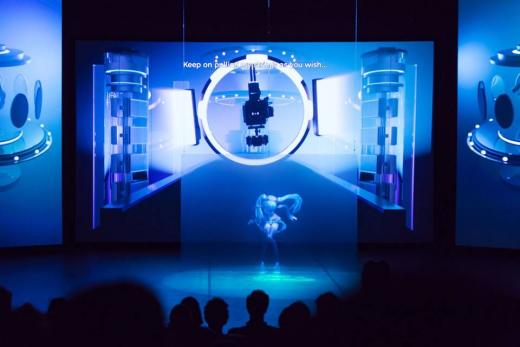Slave 4 U
Slave 4 U

Beyoncé, Britney, Rihanna, Björk, Gaga: we all know who they are. The pop idols of today.
We expect their perfection but we get twisted pleasure from witnessing human error: Ashlee Simpson lip-syncing on Saturday Night Live, Christina Aguilera flubbing the lyrics to the American national anthem at the Super Bowl, Janet Jackson’s wardrobe malfunction (although this was Justin Timberlake’s error entirely).
Soon, we may be able to add Hatsune Miku to the list of global pop stars. One doesn’t typically associate CTM Festival and Transmediale Festival with anything at all pop. But the two festivals’ joint commission, called Still Be Here, that premiered this past weekend at Haus der Kultur der Welt was anything from generic.
Initiated by artist Mari Matsutoya in collaboration with producer Laurel Halo, choreographer Darren Johnson, and artists LaTurbo Avedon and Martin Sulzer, Still Be Here was both festivals’ highlight event. It has been in development since 2014 and has gone through several artist residency programs. This year, Still Be Here has had the kind of hype around it that a superstar like Hatsune Miku only deserves.

Launched in 2007 in Japan, Hatsune Miku is a hologram, developed from a vocal synthesizer product into a collaboratively constructed cyber celebrity. She has a hopelessly devoted user community that create songs and choreography for her, countless stadium performances as a virtual 3D projection, and more than 100,000 songs released worldwide. As Miku’s creators at Crypton Future Media explain in a video during the performance, “Miku represents simultaneous production and consumption,” a user-driven experience of celebrity entertainment. Miku is a slut for her audience, her content and style in their controlling hands. Yet, at the same, time, she is an icon on her own, with her own autonomous identity.
Relevant here is the age-old chicken-or-egg question. What came first? Hatsune Miku or Hatsune Miku’s user-creator?
Hatsune has long turquoise braids, wears short skirts, is perpetually 16, and can sing and dance for eternity. You will never hear her voice crack, see her slip on stage, or catch an unsavory sound bite of hers in the media. She is a walking, gyrating paradox: sexually available but virginal and innocent, human but robot, very talented but not intimidatingly so. In Japan, she has become a cultural phenomenon, an epitome of the country’s entrenched fetish culture, a site of projected fantasies and a source of virtual escapism in a world of urban isolation.

© transmediale
The Still Be Here performance installation began with a running monage of Hatsune’s many hits and followers. We see cosplayers imitating their princess, people live-journaling their obsession with Hatsune, thousands of fans sugar-pumping to her music. 5 minutes into the performance, and we still haven’t even seen Hatsune yet. It’s a clever strategy: we are left longing for her presence.
And when Hatsune appears, on the digitally created stage or the snowy streets of Japan behind her, she is more intimate than we have ever seen her. We feel treated to a special experience, a gentler, behind-the scenes Hatsune—still immaculate, yet somehow less contrived. Still Be Here is Hatsune’s MTV Unplugged session.
Matsutoya and Halo worked together to crowdsource lyrics from Hatsune’s user-generated repertoire and use them in new pop songs. Laurel Halo’s atmospheric soundtrack perfectly captures the expansive Internet void that Hatsune exists in. The original tracks of Still Be Here are essentially pop ballads in which Hatsune promises her devotion to her audience; she will “still be here” no matter what. These song-and-dance numbers are put in tension with video interviews with Hatsune’s creators, fans, and cultural commentators.
When the performance ends, audience members go up to the stage to take a “selfie” with Hatsune Miku. We were invited to do so by the festival organizers at the beginning of the performance. A mob approaches Hatsune and begins to take photos. This moment of audience intervention demonstrates exactly why Hatsune is important today. Here is the perfect celebrity; she does not run from paparazzi or flinch at the sight of a camera. She is still, obedient, and can take an infinite amount of selfies with her fans.
Is this what we have come to expect from our entertainers, our beloveds, from all women and bodies around us?